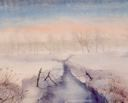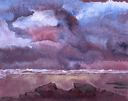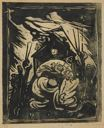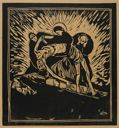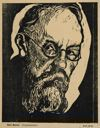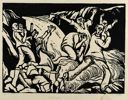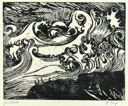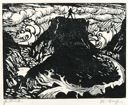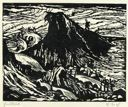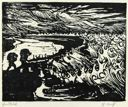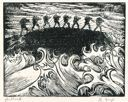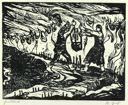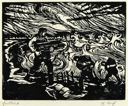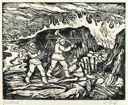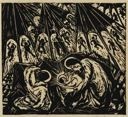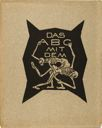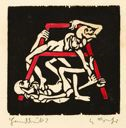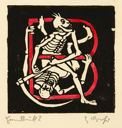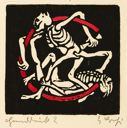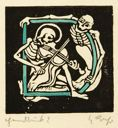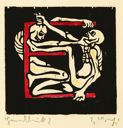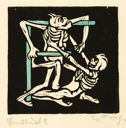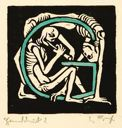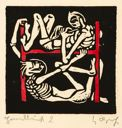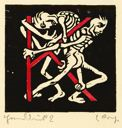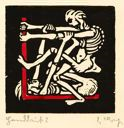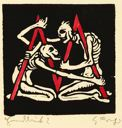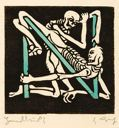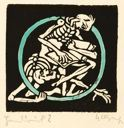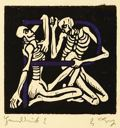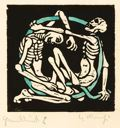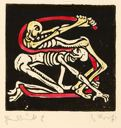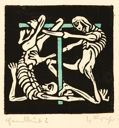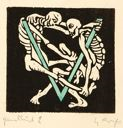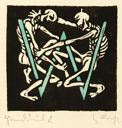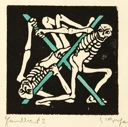Hans Grohs
German
(1892 - 1981)
The German artist, Hans Grohs, was born in 1892 in Pahlen, in the province of Schleswig Holstein, north Germany.(1) Pahlen is a coastal town on the North Sea in an area known as the Dithmarschen, a rugged landscape that figures prominently in Grohs' work. Grohs' family on his father's side were whalers and fishermen; his mother's parents were stained-glass artists. Both parents encouraged Grohs' interest in the arts and apprenticed him to a painter in Heide at the age of 16. Grohs eventually became a journeyman at the Kunstgewerbeschule in Hildesheim, Germany, then continued his art education at the Universität Königsberg.
When WWI began, Grohs was drafted into the army, but was assigned work as a librarian in Bruges, Belgium because of his poor health. While in Bruges, Grohs studied the Flemish master painters, particularly the work of Hans Memling, while continuing to work on his own paintings. After the war, Grohs enrolled in the Grossherzögliche Hochschule für die bildenen Künste (predecessor to the Bauhaus) in Weimar, Germany. During this period, Grohs turned increasingly to religious subjects, producing several series of works on themes such as the Creation, and the Life, Passion, and Death of Christ.
Grohs studied at the Weimar Academy from 1915 to 1918 under Lyonel Feininger, and in 1919, he became a master student at the Bauhaus in Weimar. His tenure at the Bauhaus was short-lived, however, and he resigned in December in protest over the changing philosophy of the program.(2) In 1921, Grohs married Elizabeth von Treskow, who died in childbirth four years later. Grohs remarried almost immediately, and he and his new wife, the sculptor, Elma Hansen, traveled to Italy where he studied the frescos of the Renaissance and Baroque, and eventually developed his own fresco technique. This visit also had a lasting impact on Grohs' style of this period, resulting in a greater emphasis in his work on line and form rather than expression or emotion.(3)
In 1934, Grohs was invited to join the faculty of the Nordische Kunsthochschule in Bremen. As a teacher, he stressed craftsmanship and worked to incorporate the teaching of applied arts into the fine arts program. During this period, his work ranged from designs for stained-glass windows to sculptures, tapestries, furniture, clothing, jewelry, and interior decorations.
In 1937, the Nazi regime declared Grohs a degenerate artist. His art was confiscated and destroyed, and he was forbidden to paint, sell, or exhibit work that was considered to touch upon religious or social protest themes. Despite this prohibition, Grohs continued to work on his poetry and painting, signing his works with the pseudonym "H. Gross Pahlen".(4) In 1943, Grohs was drafted into the Army and sent to the Russian Front as a foot solider, but he was released within a year because of poor health. His works from this period suggest a deep sense of despair, and Grohs eventually abandoned painting altogether.
After the war, Grohs returned to the Dithmarschen, but it was not until the late 1950s that he began to paint again. The themes in his poetry and art from this period are heavily religious and focus on the Dithmarschen landscape and the presence of God in nature. Grohs began to travel extensively over the next few decades, visiting the United States, the Arctic, and Norway, though he continued to make his home in Germany. He also continued to prolifically produce art, and by the 1970s, his art had begun to receive some international recognition. Grohs actively worked and exhibited until his death in 1981.
Grohs' second wife, Elma Hansen, and his oldest child by Elma, Frauken Grohs Collinson, inherited the contents of Grohs' studio on his death. Frauken Grohs Collinson began cataloging her father's graphic works, then after her mother's death, she assumed sole responsibility for the collection.(5) Since that time, she has purchased additional works by her father as well as having works in the existing collection conserved and restored, has donated a number of his works to museums both in the United States and abroad, and has loaned her father's work to a number of exhibitions.(6)
Hans Grohs' oeuvre encompasses a bewildering variety of media including fresco painting, oil painting, watercolor, woodblock printing, textile design, sculpture, and stained-glass. Late in his life, watercolor became Grohs' primary medium and he painted on watercolor paper prepared with latex toner so that he could capture the changing landscape rapidly and spontaneously. Grohs also wrote poetry, short stories, and plays.(7) He liked to combine text and imagery, and often his woodcut prints, and some of his paintings, were accompanied by poems.(8) Grohs' subject matter varied widely including portraits, self-portraits, landscapes, abstract imagery, and visionary subjects. The Dithmarschen region was a constant subject, particularly late in his career.
Grohs' early works were simple and direct in style, but by the late 1930s his works began to reflect a deep religious sensibility and an extensive personal mythology created from a number of different elements.(9) One such influence was Grohs' Nordic heritage and the myths and legends of the Dithmarschen region which he constantly turned to for inspiration. The Bible and his Lutheran faith were also constant sources for themes.(10) Grohs' ties to nature were particularly strong and essentially religious.(11) For him, nature was a metaphor for God, and the emotions he experienced in nature closely resembled his religious feelings.
Because of the diverse mixture of influences behind Grohs' work, his style is difficult to categorize.(12) Though he often has been labeled a German Expressionist, in many ways his work displays equally strong ties to the German Romantic tradition. Grohs knew, and showed with, the members of such Expressionist groups as Die Brücke, Der Blaue Reiter, and International Dada, but though he was receptive to their ideas, he did not entirely share their aesthetics. Certainly, his primary interest in conveying emotion through color, line, and abstraction identifies him with the Expressionist movement. On the other hand, Grohs' equation of nature and spirituality, and his use of color and emotion to heighten the viewer's senses and help them transcend the everyday, firmly link him to the German Romantic tradition of the early nineteenth century.(13)
(1)Biographical information has been compiled from the following sources: Edward F. Weeks, Hans Grohs: Dithmarschen Expressionist, Birmingham Museum of Art, 1977; Dr. Alfred Kamphausen, Eulogy: In Memoriam Hans Grohs (1892-1981), translated by Frauken Collinson, 1981; Annie-Paule Quinsac, Hans Grohs (1892-1981) and the Northern German Romantic Tradition, Marriner S. Eccles Federal Reserve Board Building, Washington, D. C., 1986; Mark M. Johnson, Hans Grohs: An Ecstatic Vision, Montgomery Museum of Fine Arts, 1996; Annie-Paule Quinsac, "Glimpses at Landscapes on Paper and Selected Poems: An Intimate Portrait", essay on file, Montgomery Museum of Fine Arts, 1996.
(2)A discussion of the events surrounding Grohs' resignation and a transcript of parts of his speech are given in "Results of the Investigation Concerning the Staatliche Bauhaus in Weimar", Ministry of Culture, Weimar, 1920 (copy on file, Montgomery Museum of Fine Arts). In the Weimar document, Grohs' name is spelled "Gross".
(3)Quinsac, 1986.
(4)Quinsac, 1986 gives the spelling as "H. Gross Palhen". This may be a misspelling rather than an alternate spelling.
(5)Frauken Grohs Collinson currently lives in Birmingham, Alabama.
(6)Recent exhibitions include Hans Grohs: Dithmarschen Expressionist, Birmingham Museum of Art, 1977; Hans Grohs (1892-1981) and the Northern German Romantic Tradition, Marriner S. Eccles Federal Reserve Board Building, Washington, D. C., 1986 and Hans Grohs: An Ecstatic Vision, Montgomery Museum of Fine Arts, 1996. Grohs' works can be found in the collections of the Kunsthalle in Kiel, Germany, the Von der Heydt Museum in Wuppertal, Germany, the Dithmarscher Landsmuseum in Meldorf, Germany, the Joseph and Margaret Muscarelle Museum of Art, Williamsburg, Virginia, the High Museum of Art in Atlanta, the Los Angeles County Museum of Art Robert Gore Rifkind Center in Los Angeles, and the Birmingham Museum of Art, among others.
(7)Grohs called his poems "pictures painted with words". Many of Grohs' writings are in Platt, a Low German dialect of the Dithmarschen region. These texts include unpublished dramas, oratorios, and stories as well as poetry.
(8)Examples of woodcuts accompanied by texts include the Dance of Death portfolio from 1922 with 32 poems in High German, the Uns Jungs Vereen portfolio of 1922 with accompanying poems in Low German, and the Saga of Wulf Isenbrand vun Isenborg consisting of 14 woodcuts and 54 verses in Platt.
(9)Quinsac, 1986.
(10)Weeks 1977; Quinsac 1986; Johnson 1996.
(11)"My paintings materialize in contact with nature; they are my prayers to God the Almighty."
(12)Annie-Paule Quinsac has suggested that Wilhelm Worringer's discussion of the concept of a "Nordic vision of art" in Abstraction and Empathy: A Contribution to the Psychology of Style, International University Press, New York, 1953, may be a useful starting point for analyzing Grohs' complex style.
(13)Stephen F. Eisenman, Nineteenth Century Art: A Critical History, Thames and Hudson Ltd., London, 1994, pp. 137-141.
M. Bullock 4/23/97
German
(1892 - 1981)
The German artist, Hans Grohs, was born in 1892 in Pahlen, in the province of Schleswig Holstein, north Germany.(1) Pahlen is a coastal town on the North Sea in an area known as the Dithmarschen, a rugged landscape that figures prominently in Grohs' work. Grohs' family on his father's side were whalers and fishermen; his mother's parents were stained-glass artists. Both parents encouraged Grohs' interest in the arts and apprenticed him to a painter in Heide at the age of 16. Grohs eventually became a journeyman at the Kunstgewerbeschule in Hildesheim, Germany, then continued his art education at the Universität Königsberg.
When WWI began, Grohs was drafted into the army, but was assigned work as a librarian in Bruges, Belgium because of his poor health. While in Bruges, Grohs studied the Flemish master painters, particularly the work of Hans Memling, while continuing to work on his own paintings. After the war, Grohs enrolled in the Grossherzögliche Hochschule für die bildenen Künste (predecessor to the Bauhaus) in Weimar, Germany. During this period, Grohs turned increasingly to religious subjects, producing several series of works on themes such as the Creation, and the Life, Passion, and Death of Christ.
Grohs studied at the Weimar Academy from 1915 to 1918 under Lyonel Feininger, and in 1919, he became a master student at the Bauhaus in Weimar. His tenure at the Bauhaus was short-lived, however, and he resigned in December in protest over the changing philosophy of the program.(2) In 1921, Grohs married Elizabeth von Treskow, who died in childbirth four years later. Grohs remarried almost immediately, and he and his new wife, the sculptor, Elma Hansen, traveled to Italy where he studied the frescos of the Renaissance and Baroque, and eventually developed his own fresco technique. This visit also had a lasting impact on Grohs' style of this period, resulting in a greater emphasis in his work on line and form rather than expression or emotion.(3)
In 1934, Grohs was invited to join the faculty of the Nordische Kunsthochschule in Bremen. As a teacher, he stressed craftsmanship and worked to incorporate the teaching of applied arts into the fine arts program. During this period, his work ranged from designs for stained-glass windows to sculptures, tapestries, furniture, clothing, jewelry, and interior decorations.
In 1937, the Nazi regime declared Grohs a degenerate artist. His art was confiscated and destroyed, and he was forbidden to paint, sell, or exhibit work that was considered to touch upon religious or social protest themes. Despite this prohibition, Grohs continued to work on his poetry and painting, signing his works with the pseudonym "H. Gross Pahlen".(4) In 1943, Grohs was drafted into the Army and sent to the Russian Front as a foot solider, but he was released within a year because of poor health. His works from this period suggest a deep sense of despair, and Grohs eventually abandoned painting altogether.
After the war, Grohs returned to the Dithmarschen, but it was not until the late 1950s that he began to paint again. The themes in his poetry and art from this period are heavily religious and focus on the Dithmarschen landscape and the presence of God in nature. Grohs began to travel extensively over the next few decades, visiting the United States, the Arctic, and Norway, though he continued to make his home in Germany. He also continued to prolifically produce art, and by the 1970s, his art had begun to receive some international recognition. Grohs actively worked and exhibited until his death in 1981.
Grohs' second wife, Elma Hansen, and his oldest child by Elma, Frauken Grohs Collinson, inherited the contents of Grohs' studio on his death. Frauken Grohs Collinson began cataloging her father's graphic works, then after her mother's death, she assumed sole responsibility for the collection.(5) Since that time, she has purchased additional works by her father as well as having works in the existing collection conserved and restored, has donated a number of his works to museums both in the United States and abroad, and has loaned her father's work to a number of exhibitions.(6)
Hans Grohs' oeuvre encompasses a bewildering variety of media including fresco painting, oil painting, watercolor, woodblock printing, textile design, sculpture, and stained-glass. Late in his life, watercolor became Grohs' primary medium and he painted on watercolor paper prepared with latex toner so that he could capture the changing landscape rapidly and spontaneously. Grohs also wrote poetry, short stories, and plays.(7) He liked to combine text and imagery, and often his woodcut prints, and some of his paintings, were accompanied by poems.(8) Grohs' subject matter varied widely including portraits, self-portraits, landscapes, abstract imagery, and visionary subjects. The Dithmarschen region was a constant subject, particularly late in his career.
Grohs' early works were simple and direct in style, but by the late 1930s his works began to reflect a deep religious sensibility and an extensive personal mythology created from a number of different elements.(9) One such influence was Grohs' Nordic heritage and the myths and legends of the Dithmarschen region which he constantly turned to for inspiration. The Bible and his Lutheran faith were also constant sources for themes.(10) Grohs' ties to nature were particularly strong and essentially religious.(11) For him, nature was a metaphor for God, and the emotions he experienced in nature closely resembled his religious feelings.
Because of the diverse mixture of influences behind Grohs' work, his style is difficult to categorize.(12) Though he often has been labeled a German Expressionist, in many ways his work displays equally strong ties to the German Romantic tradition. Grohs knew, and showed with, the members of such Expressionist groups as Die Brücke, Der Blaue Reiter, and International Dada, but though he was receptive to their ideas, he did not entirely share their aesthetics. Certainly, his primary interest in conveying emotion through color, line, and abstraction identifies him with the Expressionist movement. On the other hand, Grohs' equation of nature and spirituality, and his use of color and emotion to heighten the viewer's senses and help them transcend the everyday, firmly link him to the German Romantic tradition of the early nineteenth century.(13)
(1)Biographical information has been compiled from the following sources: Edward F. Weeks, Hans Grohs: Dithmarschen Expressionist, Birmingham Museum of Art, 1977; Dr. Alfred Kamphausen, Eulogy: In Memoriam Hans Grohs (1892-1981), translated by Frauken Collinson, 1981; Annie-Paule Quinsac, Hans Grohs (1892-1981) and the Northern German Romantic Tradition, Marriner S. Eccles Federal Reserve Board Building, Washington, D. C., 1986; Mark M. Johnson, Hans Grohs: An Ecstatic Vision, Montgomery Museum of Fine Arts, 1996; Annie-Paule Quinsac, "Glimpses at Landscapes on Paper and Selected Poems: An Intimate Portrait", essay on file, Montgomery Museum of Fine Arts, 1996.
(2)A discussion of the events surrounding Grohs' resignation and a transcript of parts of his speech are given in "Results of the Investigation Concerning the Staatliche Bauhaus in Weimar", Ministry of Culture, Weimar, 1920 (copy on file, Montgomery Museum of Fine Arts). In the Weimar document, Grohs' name is spelled "Gross".
(3)Quinsac, 1986.
(4)Quinsac, 1986 gives the spelling as "H. Gross Palhen". This may be a misspelling rather than an alternate spelling.
(5)Frauken Grohs Collinson currently lives in Birmingham, Alabama.
(6)Recent exhibitions include Hans Grohs: Dithmarschen Expressionist, Birmingham Museum of Art, 1977; Hans Grohs (1892-1981) and the Northern German Romantic Tradition, Marriner S. Eccles Federal Reserve Board Building, Washington, D. C., 1986 and Hans Grohs: An Ecstatic Vision, Montgomery Museum of Fine Arts, 1996. Grohs' works can be found in the collections of the Kunsthalle in Kiel, Germany, the Von der Heydt Museum in Wuppertal, Germany, the Dithmarscher Landsmuseum in Meldorf, Germany, the Joseph and Margaret Muscarelle Museum of Art, Williamsburg, Virginia, the High Museum of Art in Atlanta, the Los Angeles County Museum of Art Robert Gore Rifkind Center in Los Angeles, and the Birmingham Museum of Art, among others.
(7)Grohs called his poems "pictures painted with words". Many of Grohs' writings are in Platt, a Low German dialect of the Dithmarschen region. These texts include unpublished dramas, oratorios, and stories as well as poetry.
(8)Examples of woodcuts accompanied by texts include the Dance of Death portfolio from 1922 with 32 poems in High German, the Uns Jungs Vereen portfolio of 1922 with accompanying poems in Low German, and the Saga of Wulf Isenbrand vun Isenborg consisting of 14 woodcuts and 54 verses in Platt.
(9)Quinsac, 1986.
(10)Weeks 1977; Quinsac 1986; Johnson 1996.
(11)"My paintings materialize in contact with nature; they are my prayers to God the Almighty."
(12)Annie-Paule Quinsac has suggested that Wilhelm Worringer's discussion of the concept of a "Nordic vision of art" in Abstraction and Empathy: A Contribution to the Psychology of Style, International University Press, New York, 1953, may be a useful starting point for analyzing Grohs' complex style.
(13)Stephen F. Eisenman, Nineteenth Century Art: A Critical History, Thames and Hudson Ltd., London, 1994, pp. 137-141.
M. Bullock 4/23/97
Artist Objects











